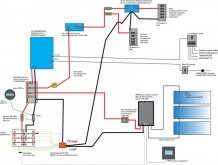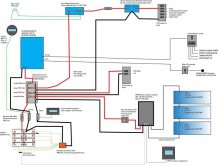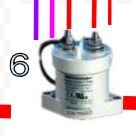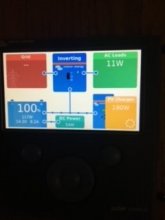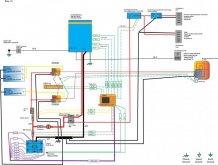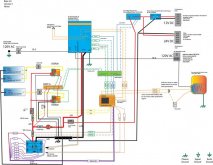thanks a lot, a really good point for using the inverter for heating water, easier to work with a 120V heating element. Did you have some kind of automatic system to activate the heating of the water with the inverter when you have overproduction on solar? I guess you can use the signal of the BMS in series to the thermostat...
I have not yet used my new electrical system yet. I've had it working on my bench with the Electrodacus BMS for some months but now moving into the van.
But I don't think an automatic diversion system is needed for a van. You'll probably be turning off your inverter when not using AC anyway, so you don't have no-load current drain 24/7. If you do have excess solar, you will be at 100% SOC so just run the inverter.
But if you do want it automatic, I think you could configure one EXTIO output to Type 4 with an SOC threshold so that its contacts are closed above that threshold and open below, and connect in series with your thermostat contacts. Since you've already used up your existing EXTIO connections, you'd need to add another optocoupler board to get more connections.
I have an Isotemp water heater and it has both an AC element and also engine coolant connections, so I'll also be able to have hot water from waste engine heat. Everyone that has these heaters says they hold heat for 24 hours. So your morning drive can heat the water for the day without even needing to run the inverter. I'm putting an inverter remote power switch in easy reach at my galley.
Last thing there is any grounding wiring of the Electrodacus I am missing?
I didn't see anything else missing on BMS connections. You do have separate EXTIO pairs going to each device, which is good. People new to this BMS sometimes make the mistake of connecting multiple devices to one EXTIO pair. Only works if the devices have same input specs and collectively don't exceed the optocoupler max current (70mA if I recall).
One other thing, if you're a belt and suspenders guy you can add an extra layer of protection using Type 5 connected to the remote power switch on the Multiplus, in addition to using the Aux inputs for normal charge control. Type 5 is a safety lock that turns off on any of several fault conditions. You can set wider limits than for normal operation. And the Multiplus remote power switch physically powers the unit on and off, vs. the Aux inputs that drive firmware. But you'd need another EXTIO pair since you've used up your existing pairs.
Why use this? It's possible to have error conditions such as a user error (inadvertantly set limits wrong, or set up Aux inputs wrong, download a FW update and unknowingly disable the Aux inputs...) or even a FW bug in the Multiplus or even the BMS. Things happen. Ironically, I actually found a bug in the Type 5 function (which Dacian fixed in a day). That's why the manual says Type 5 only works correctly after version 4.1p.
Any suggestion for the 300Amp Circuit Breaker, will you have to take care of any surge current?
I don't use a breaker, just the Class T fuse. Along with a battery switch for an inverter disconnect. You do need to pre-charge--the inverter input caps are very large and you can get 1000s of amps which will arc and damage the switch contacts over time. But pre-charging is only necessary when connecting the inverter. In normal operation, the inverter switch will remain in the on position and no need to pre-charge.
You can do it with a wire as Will does in his videos. But I don't like the spark so I used a wire with an added resistor to pre-charge when building and testing my system. Finally I decided to implement a simple pre-charge circuit using a
Blue 4-position battery switch and a 12.5 ohm resistor made from two
25 ohm power resistors in parallel. I estimated the input capacitance at about 25 mF, so that makes a time constant of about 300ms. Pausing on the pre-charge position for about 1 second to get above 95% pre-charge. Peak power dissipation in the resistor is about 63W but it is short, and these are rated 50W each.
Connections:
Output: connect to positive bus bar (yes the switch is bi-directional, I'm using output as input)
Input 1 to Input 2: 12.5 ohm power resistor connected between these two terminals
Input 2: output connection to inverter
Operation:
I labeled it with an arrow to move counter-clockwise only. Sequence is then OFF -> 1 -> 1+2 -> 2 -> OFF
OFF: no connection
1: Battery connected to inverter through the power resistor--pre-charge position--pause here for 1 second
1+2: Battery connected directly to inverter--operating position
2: Battery connected directly to inverter--also a valid operating position
OFF: back to no connection




